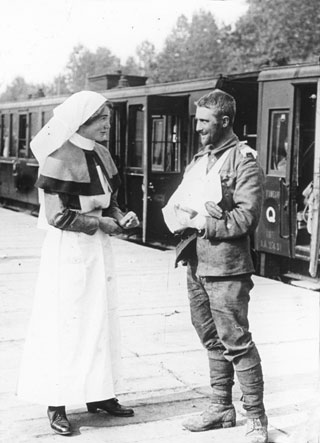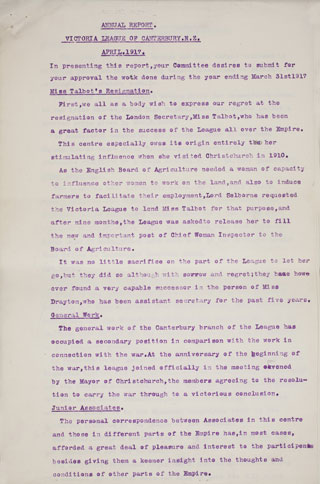Image of nurse and soldier (MB367/148847): A nurse talking to a wounded soldier, about to board a hospital train, to be transported back to Britain. (British Official Photographer; France; c.1916).

The Victoria League
Canterbury’s Imperialism:
An introduction to the Victoria League, its war work, and its significance in Canterbury’s history.
This section written by Greg Hynes.
Despite the loss of much of Christchurch’s colonial architecture due to the 2010 and 2011 earthquakes, evidence of Christchurch’s imperial heritage still abounds in local archives. The Macmillan Brown Library’s collection of First World War photographs, which came to the library through the Victoria League, is an example of this heritage. The Victoria League is an important part of the story of the collection.
The Victoria League began as an aristocratic female-imperial society. It was formed in London in 1901, named for the recently deceased Queen Victoria. 1901 was an important moment for British imperial confidence, the Second Boer War in South Africa was being fought, and with the Queen’s death the Victorian era came to an end. Victoria’s legacy was particularly significant, as the League was a predominantly female society. Membership was open to both genders, however the League was mostly made up of women. These women were ‘female imperialists’: that is, women who saw it as their place to promote empire unity from their maternal position in society.The aim of the Victoria League was to foster Commonwealth friendship and understanding throughout the empire.

Image of nurse and soldier (MB367/148847): A nurse talking to a wounded soldier, about to board a hospital train, to be transported back to Britain. (British Official Photographer; France; c.1916).
The League pursued imperial interests that played to its feminine strengths. The work of the Victoria League predominantly fell into two categories: education and hospitality. The League had empire-wide membership intentions, competing with the larger, and more successful, female imperial society the Imperial Order Daughters of the Empire, which was largely confined to Canada.
The first branch of the League established outside of Britain was in Tasmania in 1903. The league then came to New Zealand, with a second imperial branch in Otago in 1905. A Canterbury branch eventually followed in 1910. The Canterbury branch grew quickly, soon becoming one of the leading branches in New Zealand. The Canterbury branch drew its membership from the Christchurch elite. Women of the founding Deans family were members, and later became presidents of the branch. Sir Heaton Rhodes acted as Vice-President in the 1930s, while his wife had been the first president of the branch. The Victoria League maintained a strong presence in Christchurch throughout the first half of the twentieth century, and was particularly active during the First World War.
The First World War provided the Victoria League with the perfect outlet for its aims and ideologies. War brought the British Empire together through common struggle, and the League strove to promote such imperial unity. Fundraising was perhaps the most important duty of the League during the war. Some estimates claim that the League branches of New Zealand raised £750,000 during the war. The League raised enough money to make a donation of a motor ambulance to the war effort, and towards the end of the war to seriously consider donating an aeroplane or tank. However the war ended before the donation could be made.

Victoria League annual report (MB367/115645): A page of the Canterbury branch of the Victoria League of New Zealand’s annual report for 1917. These reports were sent to other branches throughout New Zealand, and to the head office in London.
The Canterbury branch also helped with the establishment of two new branches, in Wanganui and Poverty Bay. The League was also involved with propaganda. It provided soldiers with reading material such as magazines and books, and published pamphlets. In 1916 the League expanded its propaganda activities to focus on activities such as lectures and exhibitions. The slides in the Macmillan Brown Library are an example of this expanded League propaganda.
The League continued to be active in the interwar period, in particular helping British settlers to establish themselves in New Zealand, and was again active during the Second World War. In the post-war years, a time of decolonization around the British Empire, the League declined in size, influence, and significance. However, it still maintains a solid presence in Christchurch today, for instance it provides annual prizes for history students at the University of Canterbury. The Victoria League remains a vital part of Christchurch’s history, and a link to its imperial past.